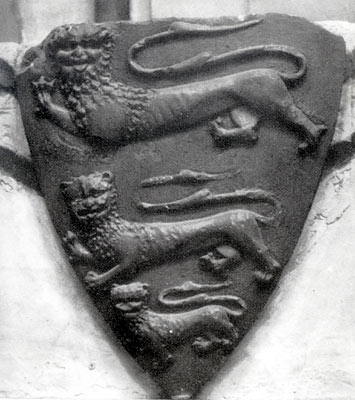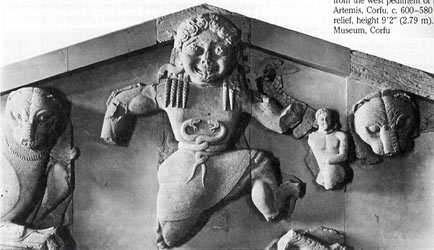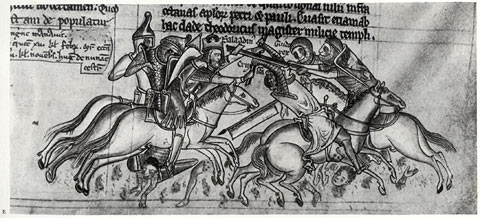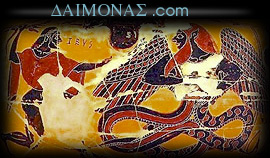
© demetrios vakras  MEDUSA & THE "ENGLISH" HERALDIC LION |
AUTHOR: about the Daimonas
| |
||
| |
|
|
 |
||
MEDUSA & THE ENGLISH HERALDIC LION
The origins of the heraldic lion that has come to be used as the symbol of the English arose during the period when the English were under the rule of France (Normans). The origin of the heraldic lion is attributed to "the east". However, "the east" has come to be distorted to mean the "Near East", or what Americans misterm "Middle East". The origin of the heraldic lion is thus attributed to the Islamic, and not the Byzantine, world. The implied origin of the heraldic lion to the lslamic world is a falsehood.
That the heraldic lion is is derived from Classical Greek lions is evidenced by its obvious borrowings when compared to Classical Greek remains such as those that are on the island of Kerkyra (better known to Anglophones by the Venetian name for the island, Corfu[sic]). It is no coincidence that French (Norman) Forces (in the guise of the Guiscards, both Robert & his son Bohemond) set up their bases for their attempted conquest of the Byzantine empire on that island.
Attribution of the origin of the Classical Greek lion has, in itself, been purported to be "Near Eastern" with the claim that it predates Classical Greek civilization, and that it arose during the so-called "Orientalizing" period of pre-Classical Greek art... Assyrian lion-hunt scenes are, it is claimed, the inspiration for the lion which appears in Classical Greek art. However, the lion-hunting scenes do not appear in Assyrian art until the Neo-Assyrian Empire which rose after the collapse of Mycenae. All the famed "Assyrian" lion hunts are taken directly off Mycenaean models which predate Assyrian representations by over 600 years. The appearance of the lion in Assyria actually follows the same path as the "Sea-Peoples" and the Aegean influences which appeared first along the Levantine coast and eventually into the hinterland.
|
"Royal Arms of Henry 3, c. 1255, Westminster Abbey, London. It is the earliest example of the 3 lions that I am aware of... Notice the lion is given a Gorgon's face with the poking out tongue...! |
Medusa and Chysaor between leopards c. 600-580 BC. Archaeological Museum Kerkyra (Corfu [sic]), Ellas (Greece). |
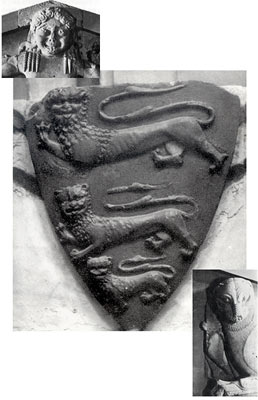 |
When the Normans exploded onto the European scene their influence extended from England to Sicily. Try as they might, the Normans, thugs of the "middle-ages", could not conquer Byzantium. First Robert Guiscard, and then his son Bohemond, failed. Ultimately Bohemond joined the rest of the body of Norman thugs in the 1st crusade, during the period when the Catholics readily drew on the Koran for guidance as much as they did their Bible. In Kerkyra (Corfu) it is undoubted that the Normans encountered lion-grave markers. Lions as grave markers had been used by the Greeks from the 6th-7th centuries BC until the advent of Christianity. Representations of lions in the Greek world are also to be found on Delos, where lions line the processional way to that island's sacred lake. At least one of these lions found its way to the Arsenal of Venice. It is on these Delian lions that the lion in Brunswick Square, England (not shown here), 1166 AD is modelled.
|
|
Right, detail from scene above, showing the lion-emblem on the shield. |
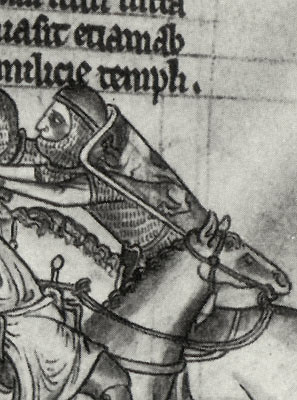 |
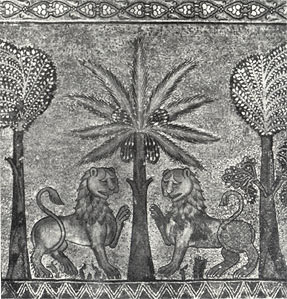 |
Left, detail of a Byzantine mosaic dating to the 12th century AD, Palermo, Sicily. The lion became one of the favourite Byzantine motifs adopted by the Norman court in Sicily. It became a symbol of the status of the Norman rulers who considered themselves the equals of the Imperial court at Byzantium. (Image source: illus B, p. 118 The Book of Art. Volume 1. Origin of Western Art, published by Grolier. ISBN 0671670077) |
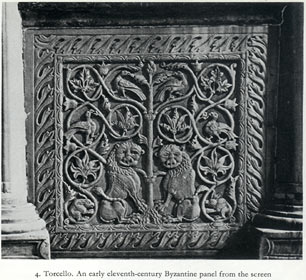 |
Left, Byzantine panel from the screen at Torcello, Italy. It dates to the early 11th century AD.
(Image source: plate 4, A History of Venice, JJ Norwich. ISBN 0140066233) |
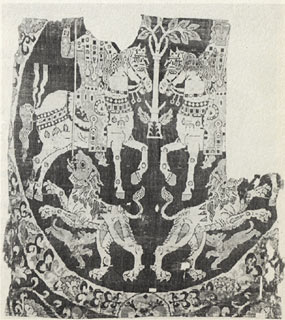 |
Left, 8th century AD,Byzantine silk depicting two lions confronted by riders wearing the Imperial costume of the Byzantine cavalry. Byzantine silks were popular in the west. (Image source: illus 59, p. 71 Art of the Byzantine Era, David Talbot Rice. ISBN 0500200041) |
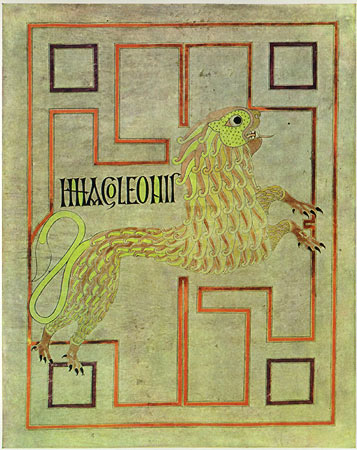
Above: Anglo-Irish.
Symbol of Saint Mark. c AD 700. National Library, France. The debt to the
lions that were depicted in Byzantine silks is obvious and indicates that
there was contact between British Isles and Byzantium. The stylised feet
are indicative that the artist here had only ever seen a lion in reproduction.

|
